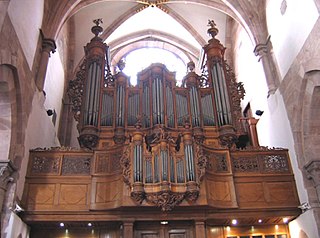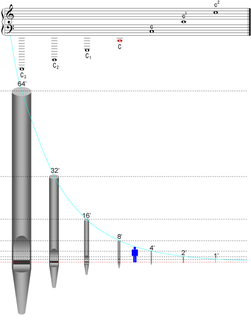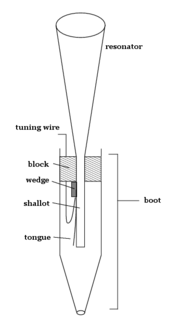Related Research Articles

The pipe organ is a musical instrument that produces sound by driving pressurized air through the organ pipes selected from a keyboard. Because each pipe produces a single pitch, the pipes are provided in sets called ranks, each of which has a common timbre and volume throughout the keyboard compass. Most organs have many ranks of pipes of differing timbre, pitch, and volume that the player can employ singly or in combination through the use of controls called stops.

In music, the organ is a keyboard instrument of one or more pipe divisions or other means for producing tones, each played with its own keyboard, played either with the hands on a keyboard or with the feet using pedals.
Principal may refer to:
Diapason may refer to:

A fipple is a constricted mouthpiece common to many end-blown flutes, such as the tin whistle and the recorder. These instruments are known as fipple flutes and are indicated by the code 421.2 in the Hornbostel–Sachs classification.

An organ stop is a component of a pipe organ that admits pressurized air to a set of organ pipes. Its name comes from the fact that stops can be used selectively by the organist; each can be "on", or "off".

The subject of this article is technical in nature and requires an understanding of organ terminology. This is in the process of being rectified. Many of the terms used here are defined in the pipe organ article.

A flue pipe is an organ pipe that produces sound through the vibration of air molecules, in the same manner as a recorder or a whistle. Air under pressure is driven through a flue and against a sharp lip called a labium, causing the column of air in the pipe to resonate at a frequency determined by the pipe length. Thus, there are no moving parts in a flue pipe. This is in contrast to reed pipes, whose sound is driven by beating reeds, as in a clarinet. Flue pipes are common components of pipe organs.

An organ pipe is a sound-producing element of the pipe organ that resonates at a specific pitch when pressurized air is driven through it. Each pipe is tuned to a specific note of the musical scale. A set of organ pipes of similar timbre comprising the complete scale is known as a rank; one or more ranks constitutes a stop.
Bourdon, bordun, or bordone normally denotes a stopped flute/flue type of pipe in an organ characterized by a dark tone, strong in fundamental, with a quint transient but relatively little overtone development. Its half-length construction make it especially well suited to low pitches, economical as well, and the name is derived from the French word for 'bumblebee' or 'buzz'.

A portative organ, also known during Italian Trecento as the organetto, is a small pipe organ that consists of one rank of flue pipes, sometimes arranged in two rows, to be played while strapped to the performer at a right angle. The performer manipulates the bellows with one hand and fingers the keys with the other. The portative organ lacks a reservoir to retain a supply of wind, thus it will only produce sound while the bellows are being operated. The instrument was commonly used in European secular music from the twelfth to the sixteenth centuries.

A flue is a duct, pipe, or opening in a chimney for conveying exhaust gases from a fireplace, furnace, water heater, boiler, or generator to the outdoors. Historically the term flue meant the chimney itself. In the United States, they are also known as vents for boilers and as breeching for water heaters and modern furnaces. They usually operate by buoyancy, also known as the stack effect, or the combustion products may be 'induced' via a blower. As combustion products contain carbon monoxide and other dangerous compounds, proper 'draft', and admission of replacement air is imperative. Building codes, and other standards, regulate their materials, design, and installation.

A reed pipe is an organ pipe that is sounded by a vibrating brass strip known as a reed. Air under pressure is directed towards the reed, which vibrates at a specific pitch. This is in contrast to flue pipes, which contain no moving parts and produce sound solely through the vibration of air molecules. Reed pipes are common components of pipe organs.

The Boardwalk Hall Auditorium Organ is the pipe organ in the Main Auditorium of the Boardwalk Hall in Atlantic City, New Jersey, built by the Midmer-Losh Organ Company. It is the largest organ in the world, as measured by the number of pipes.
Gedackt is the name of a family of stops in pipe organ building. They are one of the most common types of organ flue pipe. The name stems from the Middle High German word gedact, meaning "capped" or "covered".
This article describes the process and techniques involved in the tuning of a pipe organ. Electronic organs typically do not require tuning.
Whenever a wave forms through a medium/object with a closed/open end, there is a chance of error in the formation of the wave, i.e. it may not actually start from the opening of the object but instead before the opening, thus resulting on an error when studying it theoretically. Hence an end correction is sometimes required to appropriately study its properties. The end correction depends on the radius of the object.

Organ building is the profession of designing, building, restoring and maintaining pipe organs.

The Haskell organ pipe construction, sometimes known as "Haskelling" is a method of organ construction used when space does not permit the builder to build a full-length pipe. It consists of a shorter tube nested within another shorter tube. This construction, however, subtly alters the tone of the pipe, causing it to adopt a slightly string-like tone. The minimum height of a 16-foot pipe using this technique is around 10 feet.

Xaver Wilhelmy is an inventor, designer and certified pipe organ builder who was the first in the world to create organ pipes from glass. Wilhelmy created the Wilhelmy American Flag Glass Pipe Organ, the first pipe organ in the world with pipes made entirely from glass.
References
- ↑ Colin Pykett. "The physics of voicing organ flue pipes" . Retrieved 2 September 2020.
